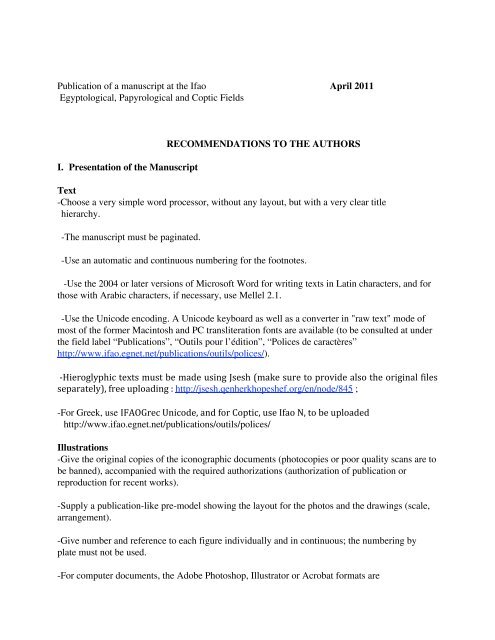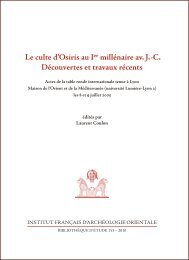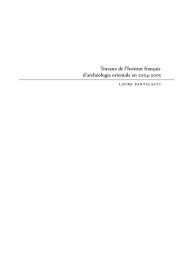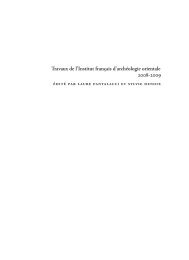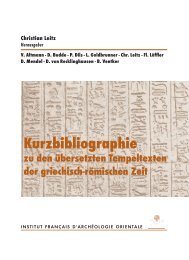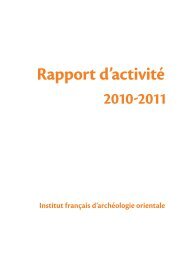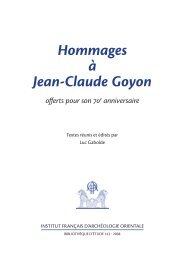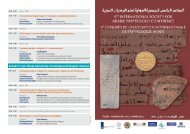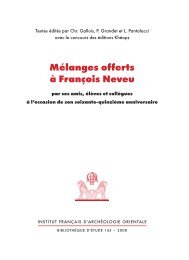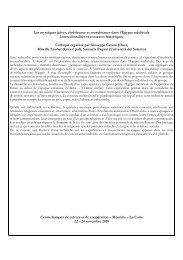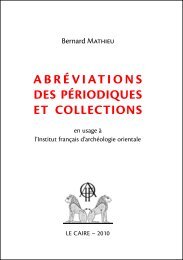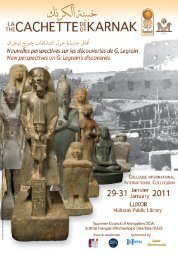RECOMMEN. anglais - Ifao
RECOMMEN. anglais - Ifao
RECOMMEN. anglais - Ifao
Create successful ePaper yourself
Turn your PDF publications into a flip-book with our unique Google optimized e-Paper software.
Publication of a manuscript at the <strong>Ifao</strong> April 2011<br />
Egyptological, Papyrological and Coptic Fields<br />
I. Presentation of the Manuscript<br />
<strong>RECOMMEN</strong>DATIONS TO THE AUTHORS<br />
Text<br />
-Choose a very simple word processor, without any layout, but with a very clear title<br />
hierarchy.<br />
-The manuscript must be paginated.<br />
-Use an automatic and continuous numbering for the footnotes.<br />
-Use the 2004 or later versions of Microsoft Word for writing texts in Latin characters, and for<br />
those with Arabic characters, if necessary, use Mellel 2.1.<br />
-Use the Unicode encoding. A Unicode keyboard as well as a converter in "raw text" mode of<br />
most of the former Macintosh and PC transliteration fonts are available (to be consulted at under<br />
the field label “Publications”, “Outils pour l’édition”, “Polices de caractères”<br />
http://www.ifao.egnet.net/publications/outils/polices/).<br />
‐Hieroglyphic texts must be made using Jsesh (make sure to provide also the original files <br />
separately), free uploading : http://jsesh.qenherkhopeshef.org/en/node/845 ;<br />
-For Greek, use IFAOGrec Unicode, and for Coptic, use <strong>Ifao</strong> N, to be uploaded <br />
http://www.ifao.egnet.net/publications/outils/polices/<br />
Illustrations<br />
-Give the original copies of the iconographic documents (photocopies or poor quality scans are to<br />
be banned), accompanied with the required authorizations (authorization of publication or<br />
reproduction for recent works).<br />
-Supply a publication-like pre-model showing the layout for the photos and the drawings (scale,<br />
arrangement).<br />
-Give number and reference to each figure individually and in continuous; the numbering by<br />
plate must not be used.<br />
-For computer documents, the Adobe Photoshop, Illustrator or Acrobat formats are
ecommended. Except particular case, black and white publication is the norm.<br />
-For iconographic recommendations, see also at www.ifao.egnet.net.<br />
II. Submission of the Manuscript<br />
-Give a complete file including a computer version (Word or RTF formats) on CD, necessarily<br />
accompanied by a paper print of the work validated by the author and accompanied by a list of<br />
the supplied elements: figures and tables with their legends. -For the BIFAO, make sure to join an<br />
anonymous version in PDF format. This version will be directly passed on to the referee. On the<br />
basis of his report and the appreciation of the editorial committee, a new version of the<br />
manuscript might be asked. The deadline to submit a manuscript for the BIFAO is fixed on May<br />
30th of every year. NB: during the proofread, some limited additions or modifications will be<br />
allowed, but the addition or the deletion of a note or a paragraph won’t be possible.<br />
III. Conventions to Respect<br />
A. Typographic Rules<br />
-For texts in English language, the typographic rules are the ones recommended by The Chicago<br />
Manual of Style.<br />
The Essential Guide for Writers, Editors, and Publishers, 15th Edition, Chicago, 2003.<br />
www.chicagomanualofstyle.org<br />
To keep in mind:<br />
-For texts in French, capital letters are accented (as for example “Aux origines de l’Égypte”).<br />
-The number of a dynasty or a century may be either spelled out – as for example the<br />
Thirteenth Dynasty – or written as follow: 13th Dynasty.<br />
-All quotations are put between the double quote “”.<br />
-The quotation marks located inside a quotation are to be written in the following way:<br />
“ ‘’ ”.<br />
- The comma, the full stop, the ellipsis, the colon, the semicolon, the question mark and the<br />
exclamation mark require no space before and one space after. The apostrophe, the hyphen, the<br />
slash and the dash require no space before and no space after. The parentheses and the square<br />
brackets require one space in the outside, no space in the inside. -The superscript number calling<br />
for a footnote is positioned after the period (dot, comma, semi colon, etc.).<br />
-For articles intended to the BIFAO or collective works such as Proceedings of Colloquiums,<br />
avoid any crossreference to internal pagination. Mention only "infra" or "supra".
B. Bibliography and Bibliographical References<br />
General Remarks<br />
First Name Abbreviation:<br />
John: J. Christophe: Chr.<br />
Flinders: Fl. Jean-Claude: J.-Cl.<br />
Using Letter Case:<br />
. • Big capital letter for patronymic and first name initial.<br />
. • Small letters for the patronymic letters others than the initial inside the text.<br />
• Small capital letters for the patronymic letters others than the initial in bibliographical<br />
references of footnotes and in the general bibliography (with the exception of an editor's name<br />
quoted after a contribution or that of an author quoted in a sentence.). NB: How to switch to<br />
small capitals: apple+shift+K for Mac or ctrl+shift+K for PC.<br />
- For the abbreviations of periodicals and collections, see:<br />
. • B. MATHIEU, Abréviations des périodiques et collections en usage à l’Institut français<br />
d’archéologie orientale, 5th ed., Cairo, 2010.<br />
PDF File: www.ifao.egnet.net > Publications > Outils pour l’édition > Abréviations périodiques.<br />
. • Lexikon der Ägyptologie VII, 1992, col. IX-XIX.<br />
-For periodicals and collections, it is useless to mention the place of publishing.<br />
1. Method to Quote the Works in Articles Footnotes<br />
Monograph (one author only)<br />
B. MIDANT-REYNES, Aux origines de l’Égypte, Du Néolithique à l’émergence de l'État, Paris,<br />
2003.<br />
P. BARGUET, Le temple d’Amon-Rê à Karnak. Essai d’exégèse, RAPH 21, 1962, 3rd ed., 2008.<br />
- while writing: “P. Barguet l’évoque également dans son inventaire des monuments de Karnak<br />
(Le temple d’Amon-Rê à Karnak. Essai d’exégèse, RAPH 21, 1962, p. 5, n. 7)”.<br />
St. QUIRKE, Lahun: a town in Egypt 1800 BC, and the history of its landscape, London, 2005.<br />
Monograph (more than one author)<br />
-For two or three authors:<br />
D. MEEKS, Chr. FAVARD-MEEKS, Les dieux égyptiens, Paris, 1993.<br />
A. DODSON, S. IKRAM, The Mummy in Ancient Egypt. Equipping the Dead for Eternity, London,<br />
1998.<br />
-For more than three authors:<br />
J. LECLANT et al., Les textes de la pyramide de Pépy I er , MIFAO 118, 2001, 2nd ed. 2010.
Collective Work (many contributions from several authors)<br />
B.E. SHAFER (ed.), Temples of Ancient Egypt, London, 1997.<br />
Chr. GALLOIS, P. GRANDET, L. PANTALACCI (ed.), Mélanges offerts à François Neveu : par ses<br />
amis, élèves et collègues à l’occasion de son soixante-quinzième anniversaire, BdE 145, 2008.<br />
Article inside a Periodical<br />
M. ABD EL RAZEK, “Study on Nectanebo I st in Luxor Temple and Karnak”, MDAIK 23, 1968, p.<br />
12-34, pl. 43-50.<br />
Article inside a Collective Work<br />
J.-Cl. GRENIER, “Une hypothèse sur l’origine des monnaies de nomes” in W. Clarysse,<br />
A. Schoors, H. Willems (ed.), Egyptian Religion. The Last Thousand Years. Studies Dedicated<br />
to the Memory of Jan Quaegebeur, OLA 85, 1998, p. 1331-1340.<br />
Article inside a Dictionary or an Encyclopaedia<br />
Br. ALTENMÜLLER, LÄ III, 1977, col. 46-47, s. v. “Horus von Libyen”.<br />
Museum Catalogue<br />
Ägyptische Inschriften aus den königlichen Museen zu Berlin I. Inschriften von der ältesten Zeit<br />
bis zum Ende der Hyksoszeit, Leipzig, 1913.<br />
Chr. ZIEGLER, Catalogue des stèles, peintures et reliefs égyptiens à l’Ancien Empire et à la<br />
Première Période Intermédiaire, musée du Louvre, Paris, 1990.<br />
Exhibition Catalogue<br />
G. ANDREU (ed.), Les artistes de Pharaon, Deir el-Médineh et la Vallée des Rois, Catalogue<br />
d’exposition, Paris, musée du Louvre 15 avril-22 juillet 2002, Paris, 2002.<br />
P. GRANDET, “La communauté d’artisans de Deir el-Médineh sous les Ramsès”, in G. Andreu<br />
(ed.), Les artistes de Pharaon, Deir el-Médineh et la Vallée des Rois, Catalogue d’exposition,<br />
Paris, musée du Louvre 15 avril-22 juillet 2002, Paris, 2002, p. 43-47.<br />
Colloquium/Congress<br />
Sch. ALLAM, “Une classe ouvrière : les merit<br />
” ,<br />
in B. Menu (ed.), La dépendance rurale<br />
dans l’Antiquité égyptienne et proche-orientale, Actes du colloque Aidea, Banyuls-sur-Mer 2001,<br />
BdE 140, 2004, p. 123-155.<br />
2. Method to Quote the Works in Monograph Footnotes<br />
B. MIDANT-REYNES, Aux origines de l’Égypte. Du Néolithique à l’émergence de l'État,<br />
2003.<br />
St. QUIRKE, Lahun : a town in Egypt 1800 BC, and the history of its landscape, 2005.<br />
J. LECLANT et al., Les textes de la pyramide de Pépy I er , 2010.<br />
M. ABD EL RAZEK, MDAIK 23, 1968, p. 12-34, pl. 43-50.<br />
J.-Cl. GRENIER, in Studies Dedicated to the Memory of Jan Quaegebeur, 1998, p. 1331-1340.<br />
Sch. ALLAM, in La dépendance rurale dans l’Antiquité égyptienne et proche-orientale, 2004,<br />
p. 123-155.
3. Rules on the Use of Abbreviations Referring to Documents already Quoted in Footnotes<br />
It is possible to use the abbreviations id. / ead. / ibid. / op. cit. / loc. cit. according to the<br />
following rules.<br />
A.H. GARDINER, Egyptian Grammar, 3rd ed., Oxford, 1957, p. 123.<br />
Id., “The Coronation of King Ḥareḥmeb”, JEA 39, 1953, pl. 4.<br />
H. SOUROUZIAN, “Raccords de statues d’Aménophis III (suite)”, BIFAO 107, 2007, p. 215.<br />
Ead., Les monuments du roi Merenptah, SDAIK 22, 1989, p. 115.<br />
M. BAUD, Famille royale et pouvoir sous l'Ancien Empire égyptien, BdE 126, 1999, p. 123, fig. 8.<br />
Ibid., p. 137, n. 3.<br />
Br. ALTENMÜLLER, LÄ III, 1977, col. 46-47, s. v. “Horus von Libyen”.<br />
M. BAUD op. cit., p. 130.<br />
M. BAUD, loc. cit.<br />
4. General Bibliography (for monograph only)<br />
BAUD, M., Famille royale et pouvoir sous l’Ancien Empire égyptien, BdE 126, 1999.<br />
BENNETT J., “Pyramid Names”, JEA 52, 1966, p. 174-176.<br />
NB: Quotation of an abbreviation used in the whole work and specific to the author (a<br />
practice which has to remain exceptional).<br />
J. SPENCER, Excavations, 1997 = SPENCER J., Excavations at Tell el-Balamun. 1992-1996,<br />
BME 1, 1997.<br />
5. Other Possible System (a general bibliography is therefore also necessary for articles)<br />
Method to Quote the Works in the Footnotes<br />
KAISER 1957, p. 74.<br />
TEFNIN 1979a, p. 55.<br />
TEFNIN 1979b, p. 236.<br />
while writing: “Tefnin (1979b, p. 55) thinks that….”<br />
General Bibliography<br />
KAISER 1957<br />
W. Kaiser, « Zur inneren Chronologie der Naqada-Kultur », Archaeologia Geographica 6,<br />
p. 69-77.<br />
TALLET 2005<br />
P. Tallet, Sésostris III et la fin de la XII e dynastie, Paris.<br />
TEFNIN 1979a<br />
R. Tefnin, La statuaire d’Hatshepsout : Portrait royal et politique sous la 18 e Dynastie,<br />
MonAeg 4.<br />
TEFNIN 1979b<br />
R. Tefnin, « Image et histoire. Réflexions sur l’usage documentaire de l’image<br />
égyptienne », CdE 54, p. 218-244.


